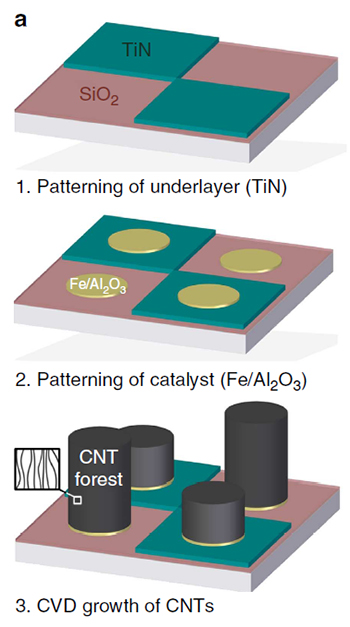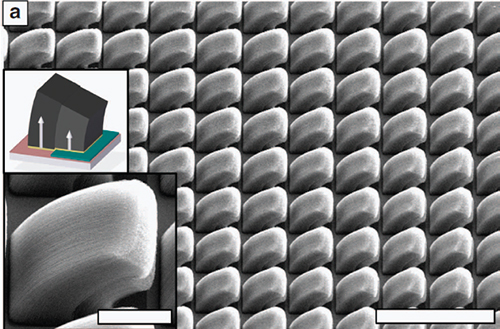X-RAY RUNS: Apply for Beamtime
2017 Nov 1 - Dec 21
2018 Feb 7 - Apr 3
2018 Proposal/BTR deadline: 12/1/17
2018 Apr 11 - Jun 4
2018 Proposal/BTR deadline: 2/1/18
Materials in nature are often complex and ingenious, challenging scientists and engineers to mimic their functionality or try to improve upon effective and efficient solutions. For example, the skins of many plants and animals have intricate microscale features that give rise to useful properties such as repelling water, adhesion, color-adaptation, camouflage, and resistance to wear or degradation. Try as we have, it is still very difficult or impossible to achieve efficient top–down fabrication processes. With this project, collaborators from the Hart group (University of Michigan) and De Volder (University of Cambridge and Belgium) demonstrated a new technique for scalable manufacturing of freeform microstructures making use of strain-engineered growth to aligned carbon nanotubes (CNTs). Offset patterning of the CNT growth catalyst is used to locally modulate the CNT growth rate. This causes the CNTs to collectively bend during growth, with exceptional uniformity over large areas. The final shape of the curved CNT microstructures can be designed via finite element modeling, and compound catalyst shapes produce microstructures with multidirectional curvature and unusual self-organized patterns.
Conformal coating of the CNTs enables tuning of the mechanical properties independently from the microstructure geometry, representing a versatile principle for design and manufacturing of complex microstructured surfaces. This process used to fabricate these complex surfaces leverages the influence of catalyst–substrate interactions on the growth rate of CNTs, creating strain gradients during synthesis that guide the CNTs into curved microscales. Small-angle x-ray scattering (SAXS) characterization was performed at the CHESS G1 beamline using a focused 10 micron spot produced by an in-house fabricated single bounce glass monocapillary.

Figure 1. Growth of CNT micropillars using TiN as a rate-controlling catalyst underlayer. Shown are process steps including two lithography steps and growth on alternating TiN squares on SiO2.

Figure 2. The micropillars are grown from catalyst rectangles partially overlapping TiN (shown as green layer in the schematics, see inset) and bend towards the TiN side, which grows more slowly and couples to the faster-growing region of catalyst directly on SiO2. Scale bars are 100 micron (in panel) and 20 micron (inset).
Reference:
[1] De Volder, M., S. Park, S. Tawfick, and A. J. Hart, "Strain-Engineered Manufacturing of
Freeform Carbon Nanotube Microstructures", Nat Commun 5 (07/29/online 2014).
See: http://www.nature.com/ncomms/2014/140729/ncomms5512/full/ncomms5512.html#acknowledgments
Submitted by: Ernest Fontes, CHESS, Cornell University
10/10/2014
